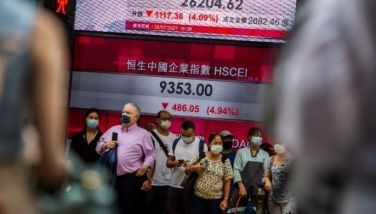StanChart sees peso weakening in Q2
April 21, 2007 | 12:00am
Standard Chartered Bank (SCB) sees the peso weakening in the second quarter. SCB, one of the oldest banks operating in the country, is also forecasting a cut in interest rates and a slow down in gross domestic product (GDP) growth for 2007.
In a presentation, SCB regional economist Frances Cheung said the peso will weaken in the second quarter due to poor investor sentiments and anxiety over the results of the May elections.
"Key risks are a reversal of the regional risk appetite, an unexpected sharp global slowdown, and the usual Philippine political noise," she added.
Historically, the Philippines is vulnerable to market volatility triggered by falling confidence in emerging markets, which may see higher volatility as global growth and interest rate cycles turn.
However, the peso is expected to strengthen in the second semester closing at P48.30 to the dollar.
That is attributed to continued strong OFW inflows which are expected to grow by at least 14 percent this year, and strong consumption spending, mostly fueled again by remittances.
The dollar is expected to rebound in the third quarter resulting in the weakening of most Asian currencies, although the peso will remain stable due to strong remittances.
An area of concern is the price of oil which is expected to stay within the $57 to a barrel level.
Cheung expects the Bangko Sentral ng Pilipinas (BSP) to cut interest rates by a total of 50 basis points (bps).
"The central bank will cut rates by 25 bps soon, and another 25 bps by the fourth quarter," the SCB economist said. The global financial institution also expects the BSP to ultimately lift the tiering system in favor of a single rate.
"The central bank will first assume a wait-and-see attitude and see how the market will react before it acts on the tiering system," she added.
The US Federal Reserve (US Fed) is also expected to chop rates by a total of 75 bps within the year through a number of tranches.
"That action will in fact strengthen the US economy as more fixed income investments will enter their market, which should also result in a stronger dollar from its first semester performance," the SCB said.
Gross domestic product (GDP) is forecast to grow by 5.1 percent much lower than the 6.1 percent set earlier by the National Government.
Remittances will expand by at least 14 percent. In the first two months of 2007, OFW inflows grew 22.6 percent to $2.2, billion from the $1.8 billion recorded the previous year.
The BSP forecasts remittances through the formal sector to reach $14 billion.
The SCB, however, expects exports to decelerate by five to 10 percent, while manufacturing and agriculture will continue to shrink. Only the services sector will see steady growth.
In a presentation, SCB regional economist Frances Cheung said the peso will weaken in the second quarter due to poor investor sentiments and anxiety over the results of the May elections.
"Key risks are a reversal of the regional risk appetite, an unexpected sharp global slowdown, and the usual Philippine political noise," she added.
Historically, the Philippines is vulnerable to market volatility triggered by falling confidence in emerging markets, which may see higher volatility as global growth and interest rate cycles turn.
However, the peso is expected to strengthen in the second semester closing at P48.30 to the dollar.
That is attributed to continued strong OFW inflows which are expected to grow by at least 14 percent this year, and strong consumption spending, mostly fueled again by remittances.
The dollar is expected to rebound in the third quarter resulting in the weakening of most Asian currencies, although the peso will remain stable due to strong remittances.
An area of concern is the price of oil which is expected to stay within the $57 to a barrel level.
Cheung expects the Bangko Sentral ng Pilipinas (BSP) to cut interest rates by a total of 50 basis points (bps).
"The central bank will cut rates by 25 bps soon, and another 25 bps by the fourth quarter," the SCB economist said. The global financial institution also expects the BSP to ultimately lift the tiering system in favor of a single rate.
"The central bank will first assume a wait-and-see attitude and see how the market will react before it acts on the tiering system," she added.
The US Federal Reserve (US Fed) is also expected to chop rates by a total of 75 bps within the year through a number of tranches.
"That action will in fact strengthen the US economy as more fixed income investments will enter their market, which should also result in a stronger dollar from its first semester performance," the SCB said.
Gross domestic product (GDP) is forecast to grow by 5.1 percent much lower than the 6.1 percent set earlier by the National Government.
Remittances will expand by at least 14 percent. In the first two months of 2007, OFW inflows grew 22.6 percent to $2.2, billion from the $1.8 billion recorded the previous year.
The BSP forecasts remittances through the formal sector to reach $14 billion.
The SCB, however, expects exports to decelerate by five to 10 percent, while manufacturing and agriculture will continue to shrink. Only the services sector will see steady growth.
BrandSpace Articles
<
>
- Latest
- Trending
Trending
Latest
Trending
Latest
Recommended



























